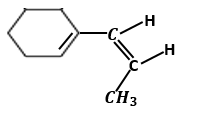The reagents used for the following conversion is/are-

1.
(i) NaNH2 , (ii) CH3CHO
2.
(i) NaNH2 , (ii) CH3-CH2-CH2-Br
3.
(i) KOH, (ii) CH3-CH2-CH2-Br
4.
(i) KOH, (ii) 


Which alkyne(s) will yield 3-ethylhexane upon catalytic hydrogenation?
| 1. |  |
2. |  |
| 3. |  |
4. | All of the above |
; Product (B) is :
1.
2. 
3.
4. Br-(CH2)12-CH=CH
Ph - C Major product of the reaction is:
(a)
(b)
(c) Ph - C C-OMe
(d)
To carry out the above conversion, (A) and (B) respectively are:
1. NaNH2, Cl - CH2ーCH2 - CH2 - Br
2. NaNH2, CH2-CH2-CH2-Br
3. NaNH2, l-CH2ーCH2-CH2-Br
4. NaNH2, I-CH2-CH2-CH2-I
H-CC-Ph 
| 1. |  |
2. |  |
| 3. | \(\mathrm{Ph}-\mathrm{C} \equiv \mathrm{C}-\mathrm{I}\) | 4. | \(\mathrm{I}-\mathrm{C} \equiv \mathrm{C}-\mathrm{H}\) |
A compound that gives an optically inactive compound on treatment with H2(2 moles)/ Pt is-
1. 3-Methyl-1-pentyne
2. 4-Methyl-1-hexyne
3. 3-Methyl-1-heptyne
4. None of the above
Compound (x) will be:
(a)
(b)
(c)
(d)
Which alkyne yields butanoic acid (CH3CH2CH2CO2H) as the only organic product on treatment with ozone followed by the hydrolysis?
1. 1-Butyne
2. 4-Octyne
3. 1-Pentyne
4. 2-Hexyne






















